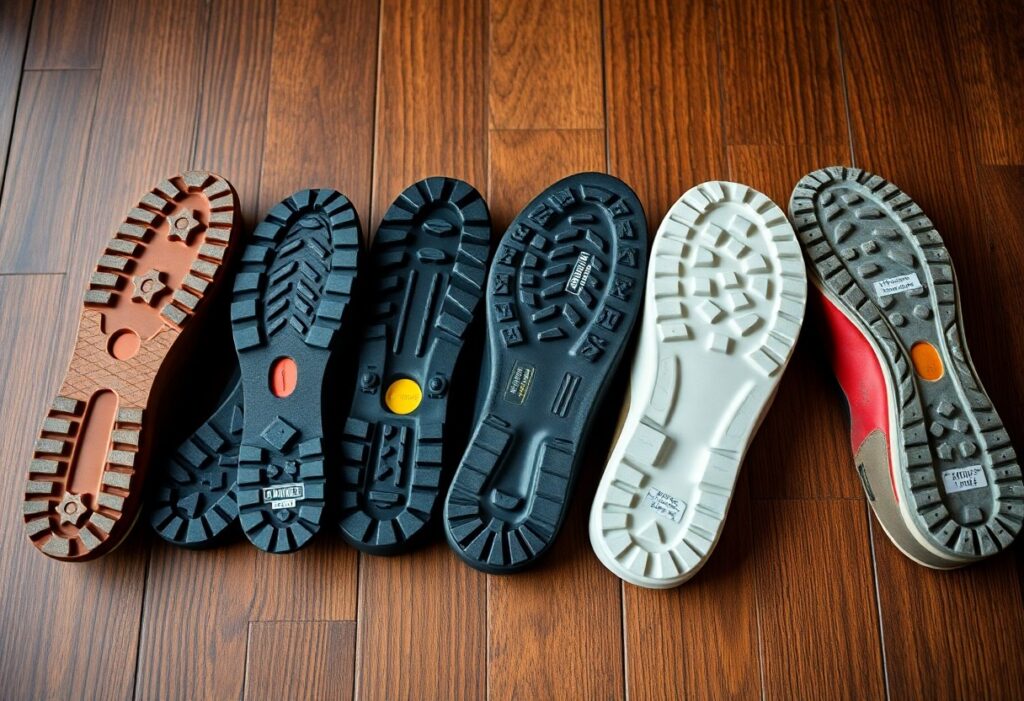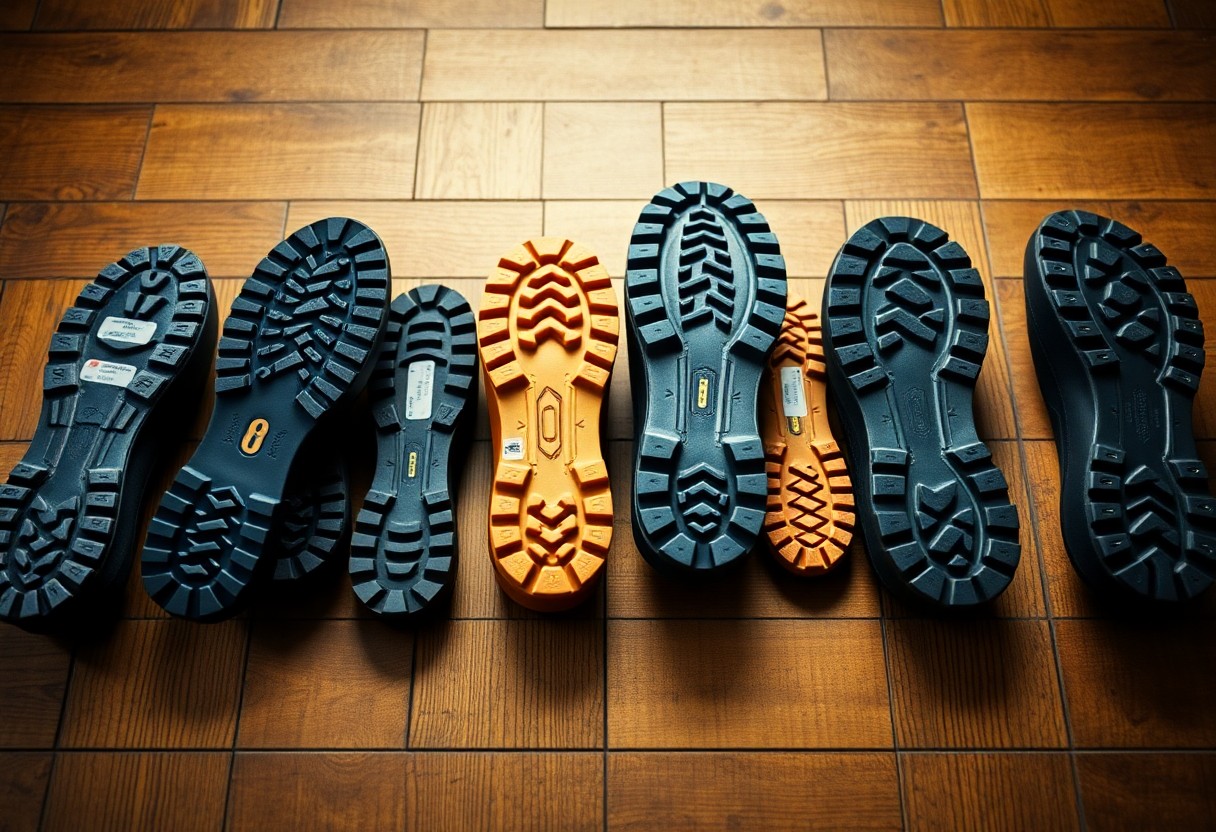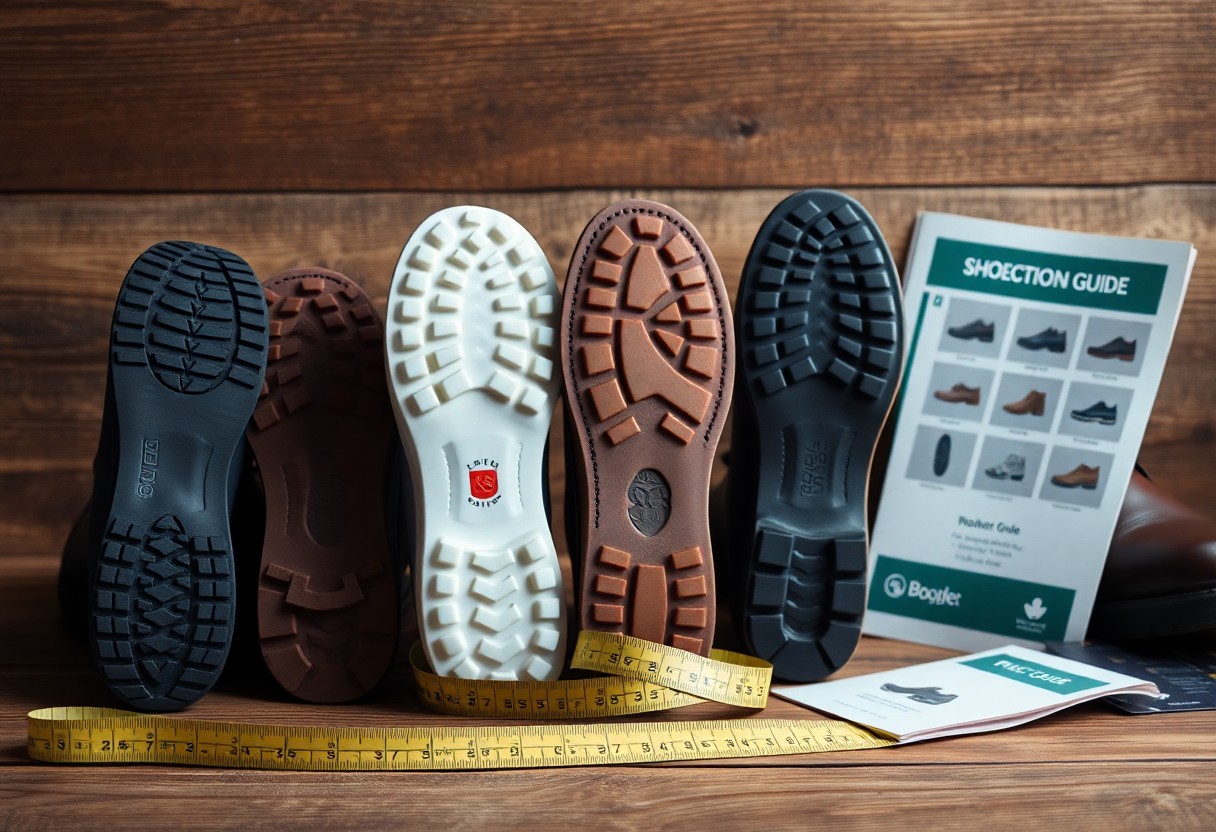
When it comes to choosing the perfect footwear, many people often overlook the vital importance of shoe soles. However, this critical element has a profound impact on your overall comfort and safety. The sole you select can be the deciding factor between achieving secure footing on slippery surfaces and facing hazardous slips, as well as enjoying long-lasting comfort versus dealing with quick deterioration. From traditional leather soles to modern rubber innovations, each sole type presents distinct benefits tailored for specific needs. You can choose from single leather, double leather, rubber, and hybrid soles, each meticulously designed for various conditions and uses. This comprehensive guide aims to illuminate the defining characteristics of different sole types and help you make the optimal choice for your unique requirements, whether you need footwear for professional environments, casual outings, or adventurous outdoor activities.

Discover the Unique Benefits of Leather Soles to Enhance Your Footwear Performance
Your choice of leather soles can dramatically influence both the style and functionality of your shoes. These classic soles are celebrated for their superior breathability and natural comfort, as they adapt to the shape of your feet over time, offering a customized fit. While they require more maintenance compared to synthetic options, leather soles provide excellent ground feel, making them especially suitable for formal events where elegance is essential. By understanding the specific advantages of leather soles, you can make an informed decision that enhances not just your wardrobe but also your overall walking experience.
Elevate Your Style with the Timeless Appeal of Single Leather Soles for Dress Shoes
Soles made from a single layer of leather represent the most classic option for sophisticated dress shoes. These soles are engineered to offer exceptional flexibility combined with a refined look, elevating your outfit for formal occasions. While they provide better breathability than rubber alternatives, it's essential to exercise caution and care when walking in wet conditions to prevent potential damage. By selecting single leather soles, you not only embrace a sophisticated aesthetic but also enjoy the comfort that quality craftsmanship provides, making every step a pleasure.
Benefit from Increased Longevity with Double Leather Soles
With two layers of leather, double leather soles offer greater durability and superior insulation against cold surfaces. Although they may feel slightly firmer than single-layer options, they provide enhanced protection for your feet across various conditions. This design ensures that double leather soles will significantly outlast their single counterparts, making them a worthwhile investment for everyday wear. They are particularly advantageous for individuals with a heavier stature or those who frequently partake in outdoor activities, although they do require a more extended break-in period to maximize comfort.
Choosing double leather soles means opting for a solution that balances longevity and performance, ensuring your footwear can endure the demands of daily use while maintaining a stylish appearance.
Optimize Your Footwear Experience with HAF (Half and Full) Soles
Combining single leather in the waist and heel with double leather in the forepart, HAF soles provide you with the best of both worlds. This innovative construction guarantees extra durability in high-wear areas while still preserving a sleek and elegant profile. The unique design of HAF soles also promotes balanced weight distribution and enhanced comfort, effectively safeguarding areas subject to wear without compromising the shoe’s refined look. It's crucial to ensure your cobbler incorporates the correct heel compensation to achieve optimal balance tailored to your feet.
Explore the Versatility of Natural and Mixed Soles for Everyday Comfort
Natural and mixed soles offer a well-balanced blend of comfort and durability. These soles are composed of organic materials such as cork, natural rubber, or leather, combined with synthetic compounds to create adaptable and high-performing footwear options. Your selection among the various natural and mixed soles should be based on your specific requirements regarding grip, weight, and weather resistance. Understanding these parameters will empower you to make an informed decision that aligns with your lifestyle and daily activities.
Experience the Featherlight Comfort of Nitrile Cork Soles
In addition to traditional rubber options, nitrile cork soles present a lightweight alternative that maintains impressive durability. These soles, which blend cork with nitrile rubber, are 30% lighter than standard rubber soles, making them a favored choice for American footwear where comfort is paramount. Available in both smooth and treaded patterns, nitrile cork soles are perfect for individuals who prioritize lightweight shoes without compromising on performance. Opting for these soles allows you to navigate your daily routine with ease and style.
Enjoy Everyday Relaxation with Natural Crepe Soles
Constructed from pure rubber, natural crepe soles provide exceptional comfort thanks to their soft cushioning properties. These soles are ideally suited for casual footwear, offering varying levels of grip based on the surfaces you encounter. Although crepe soles deliver superior comfort for daily wear, they do have some drawbacks. Their softer nature results in a wear rate that is approximately 40% faster than traditional rubber soles, and their grip may become unreliable on wet surfaces. While many users appreciate the comfort they provide, it’s important to consider the likelihood of needing more frequent replacements.

Unlock the Benefits of Rubber Soles for Optimal All-Weather Performance
Rubber soles excel in providing superior grip and water resistance, making them a standout choice for shoes and boots. These soles are particularly advantageous in wet conditions, making them an ideal selection for everyday wear in various weather scenarios. Rubber soles not only offer excellent durability but also require less maintenance compared to leather options, although they may feel warmer during the hotter summer months. The practical advantages of rubber soles make them a smart choice for anyone seeking reliable performance and comfort.
Achieve a Harmonious Blend with Rubber Topy Soles
Rubber Topy soles represent an exceptional blend of leather and rubber features, providing you with the best of both worlds. You gain the classic look of leather soles while enjoying enhanced grip and durability. A thin rubber layer is affixed to a slightly sanded leather sole, significantly extending the life of your footwear by up to 50%. This combination allows you to appreciate the aesthetic charm of leather without sacrificing functionality, making Rubber Topy soles a wise investment for your shoe collection.
Balance Style and Practicality with City Rubber Soles
By opting for city rubber soles, you achieve a sleek, dress shoe appearance without compromising practicality. These thin rubber soles closely mimic traditional leather soles while offering superior traction and waterproofing. Increasingly popular in today’s dress shoes, city rubber soles not only enhance the visual allure of your footwear but also improve durability compared to leather soles, necessitating less frequent resoling. Ideal for urban settings, these soles can easily navigate concrete sidewalks and occasional rain, ensuring you remain stylish and comfortable.
Enhance Durability with Dainite and Studded Soles
Among rubber options, Dainite and studded soles provide maximum durability and grip. Their distinctive studded design ensures reliable traction while maintaining a formal appearance, making them particularly suitable for business casual footwear and dress boots. While Dainite soles are highly resistant to wear, it's important to note that they can become slippery in freezing temperatures. User experiences may vary, as some find them firmer than other sole types. Nevertheless, for everyday use in moderate conditions, these soles generally outlast traditional leather soles by 2-3 times, establishing them as an excellent choice for durability.
Essential Performance Features of Shoe Soles You Should Know
Your selection of shoe sole can significantly impact your daily comfort and safety. Different types of soles offer varying levels of grip, shock absorption, and flexibility, each serving specific purposes that range from preventing slips on wet surfaces to alleviating foot fatigue during extended periods of walking. Gaining insight into these performance features can guide you in choosing the right sole type for your needs, enhancing your overall footwear experience.
Assess Longevity Factors in Sole Materials
The durability of different sole materials can vary greatly in terms of wear resistance. Typically, rubber compounds outlast leather soles by 3-4 times, while nitrile cork serves as a middle ground. Factors such as material density and tread pattern are crucial in determining how long your soles will endure. Being aware of these durability factors empowers you to make cost-effective footwear choices tailored to your specific lifestyle.
Understand Weather Resistance for Optimal Sole Performance
Factors such as water resistance, temperature tolerance, and traction are vital in assessing how your soles perform under various conditions. Generally, rubber soles provide superior grip in wet environments, while leather soles excel in dry ones. Remember that temperature fluctuations can significantly affect sole performance. Some rubber compounds may become dangerously hard in freezing conditions, while others retain their flexibility. Your local climate should influence your selection: city rubber soles work best for mild wet conditions, whereas specialized winter soles offer enhanced safety in snowy or icy environments.

Your Comprehensive Roadmap to Choosing the Ideal Shoe Sole
It’s important to recognize that not all shoe soles are created equal; your choice should be aligned with your individual needs and preferences. The right sole type can dramatically influence your comfort, safety, and footwear longevity. This guide is intended to assist you in selecting the most appropriate sole type based on your lifestyle, activities, and environmental considerations.
Evaluate Your Daily Activities When Selecting a Sole
When choosing a sole, essential factors to consider include your daily activities and the walking surfaces you frequently encounter. In office settings, thin leather or city rubber soles are suitable choices. Conversely, industrial settings benefit from thicker rubber or studded soles that offer improved protection. For outdoor activities, it is crucial to focus on grip requirements and durability needs. Understanding your primary usage scenarios will help you narrow down the best options available for your footwear.
Analyze Climate Conditions for Optimal Sole Performance
In addition to weather conditions, temperature variations can influence the performance of shoe soles. Here are some essential considerations:
- Wet conditions – rubber soles offer enhanced grip
- Cold weather – thicker soles provide superior insulation
- Hot climates – breathable leather soles are preferable
- Variable weather – hybrid soles present great versatility
Understanding your local climate patterns is crucial for selecting the most suitable sole type for your footwear.
Moreover, it’s essential to consider how different sole materials react to varying weather conditions:
- Leather soles require special care in wet environments
- Rubber soles may become very hard below freezing temperatures
- Nitrile cork offers a good balance in moderate conditions
- City rubber soles provide year-round versatility
Being informed about these characteristics ensures your footwear will perform excellently in any season.
Essential Maintenance and Care Tips for Longevity
To prolong the life and performance of your shoe and boot soles, regular maintenance is essential. The lifespan of your soles significantly depends on proper care, which includes cleaning, drying, and protective treatments. Each sole material has specific care requirements; for instance, leather soles need waterproofing, while rubber soles benefit from routine debris removal.
Establish Consistent Cleaning Practices for Your Footwear
A well-maintained sole starts with a regular cleaning routine. To preserve the integrity of your footwear, you should:
- Utilize a soft brush to gently remove dirt
- Clean with mild soap and water
- Apply specialized cleaners tailored for specific materials
- Ensure thorough drying after cleaning
Recognizing the appropriate cleaning methods for your specific sole type will help prevent damage and extend the life of your footwear.
Implement Preservation Strategies for Prolonged Sole Life
To extend the life of your soles, consider the following tips:
- Rotate your footwear daily to allow for adequate airing
- Use shoe trees during storage to maintain shape
- Apply protective sprays periodically for added protection
- Regularly check for wear patterns to identify signs of deterioration
By recognizing the early indications of wear, you can take proactive steps to prevent permanent damage to your footwear.
It's important to realize that preservation techniques can differ significantly based on the sole type:
- Leather soles necessitate waterproofing every 3-4 months
- Rubber soles should be routinely checked for cracks
- Cork soles need protection from moisture
- Crepe soles should be kept away from extreme heat
Understanding the specific needs of your sole type ensures optimal maintenance and longevity of your footwear.
Make Empowered Choices for Your Footwear Needs
Your selection of shoe sole is pivotal in determining your comfort and overall performance. Aligning your sole type with your unique needs is essential—whether that means opting for leather soles for formal occasions or rubber options for unpredictable weather conditions. Factors such as your lifestyle, walking surfaces, and local climate should guide your selection process. For instance, a single leather sole offers elegance for dress shoes, while Dainite or city rubber soles enhance grip and durability. By deepening your understanding of various sole types and their specific benefits, you can make informed footwear decisions that cater to your daily requirements and personal preferences.
Frequently Asked Questions about Shoe Soles
Q: What are the main differences between leather and rubber soles?
A: Leather soles are renowned for their superior breathability and ability to mold to the shape of your feet over time, making them ideal for dress shoes. They excel in dry conditions but require careful handling in wet environments. On the other hand, rubber soles offer enhanced water resistance and grip, typically last longer, and are suitable for various weather conditions. Additionally, rubber soles tend to be more budget-friendly and require less maintenance compared to leather soles.
Q: How can I choose the right sole type to fit my daily needs?
A: To select the best sole type, consider your primary environments and activities. For formal office settings, opt for leather soles, while rubber soles are better suited for outdoor walking and wet conditions. For versatile usage across different weather scenarios, studded soles like Dainite are an excellent choice. For casual outings, crepe soles provide great comfort but may wear out more quickly. Matching your sole type to your most frequent activities and environmental conditions ensures optimal performance.
Q: What benefits do double soles offer compared to single soles?
A: Single soles provide greater flexibility and a sleeker appearance, making them perfect for dress shoes. In contrast, double soles are designed for enhanced durability and better insulation against cold and wet conditions. They are well-suited for casual shoes and boots but do require a longer break-in period. While double soles may add some weight to the shoe, they also provide additional protection for challenging terrains.
The Article Guide to shoe and boot sole types features benefits and how to choose the right one appeared first on My Shoes Finder
The Article Shoe and Boot Sole Types: Features, Benefits, and Selection Tips Was Found On https://limitsofstrategy.com


You raise a critical point about shoe soles that I think often gets overlooked. I’ve personally experienced the difference between high-quality leather soles and cheaper alternatives. My go-to pair for work features double leather soles, which not only provide a classic look but also offer incredible durability and support throughout long days on my feet.
You’ve touched on a really crucial aspect of footwear that often flies under the radar, yet can make all the difference in our day-to-day comfort and safety. I remember when I first started paying attention to shoe soles; it was during a hiking trip where I realized how the type of sole could drastically change the experience. I had chosen a pair of hiking boots with rugged rubber soles, while my friend opted for stylish but less practical shoes. As we navigated through some muddy trails, I quickly appreciated the value of that decision!
It’s fascinating how those moments in the great outdoors can really open our eyes to the practical side of footwear. Your experience highlights a great point about the balance between style and functionality. While we often gravitate towards shoes that look good, when you’re out in nature, the right sole can turn a potentially muddy hike into a comfortable adventure instead of a slip-and-slide ordeal.
Your exploration of shoe soles highlights a crucial yet often underestimated aspect of footwear that many consumers overlook. I appreciate how you’ve emphasized the tangible differences between various materials—especially the practical implications for different environments and activities. For instance, I’ve noticed that while leather soles can offer elegance and comfort in formal settings, their performance in wet or uneven conditions can be quite lacking. Conversely, rubber soles truly shine in more rugged terrains, providing both grip and durability.